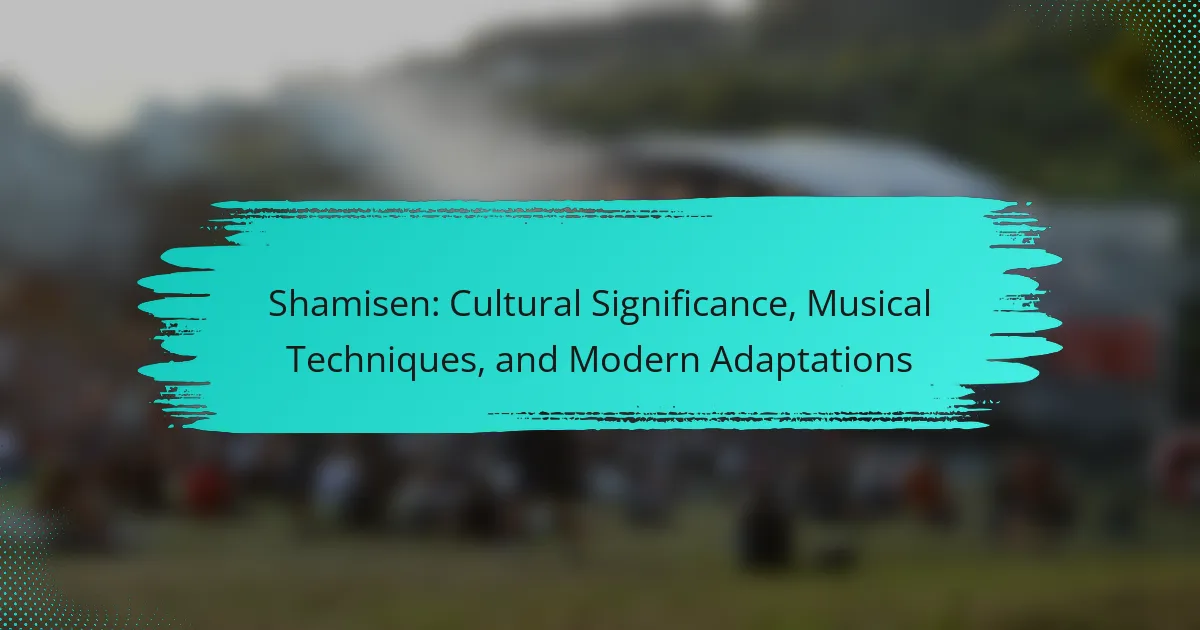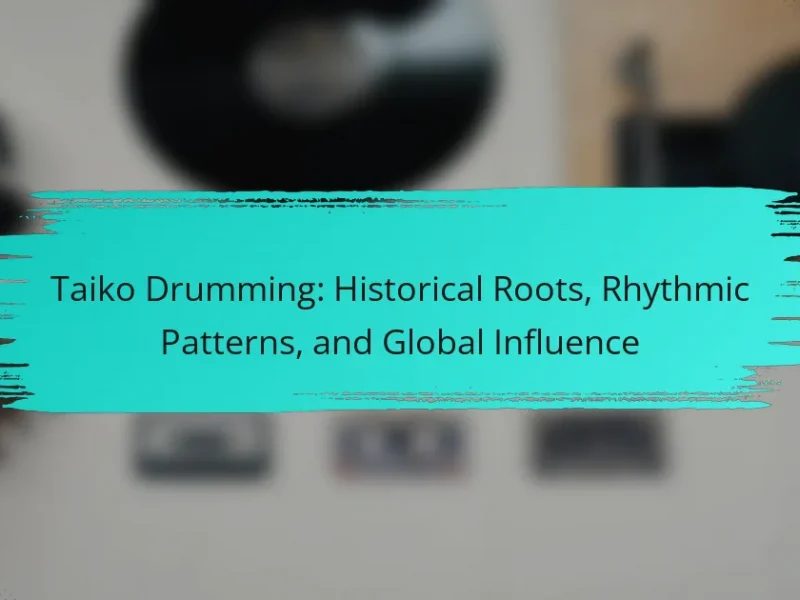Shamisen is a traditional Japanese instrument that plays a crucial role in cultural practices and emotional expression. This article explores its cultural significance, essential musical techniques, and modern adaptations that keep it relevant today. Discover the unique characteristics of different Shamisen types and the challenges musicians face in preserving this art form. Learn how aspiring players can master this versatile instrument while engaging with contemporary music styles.
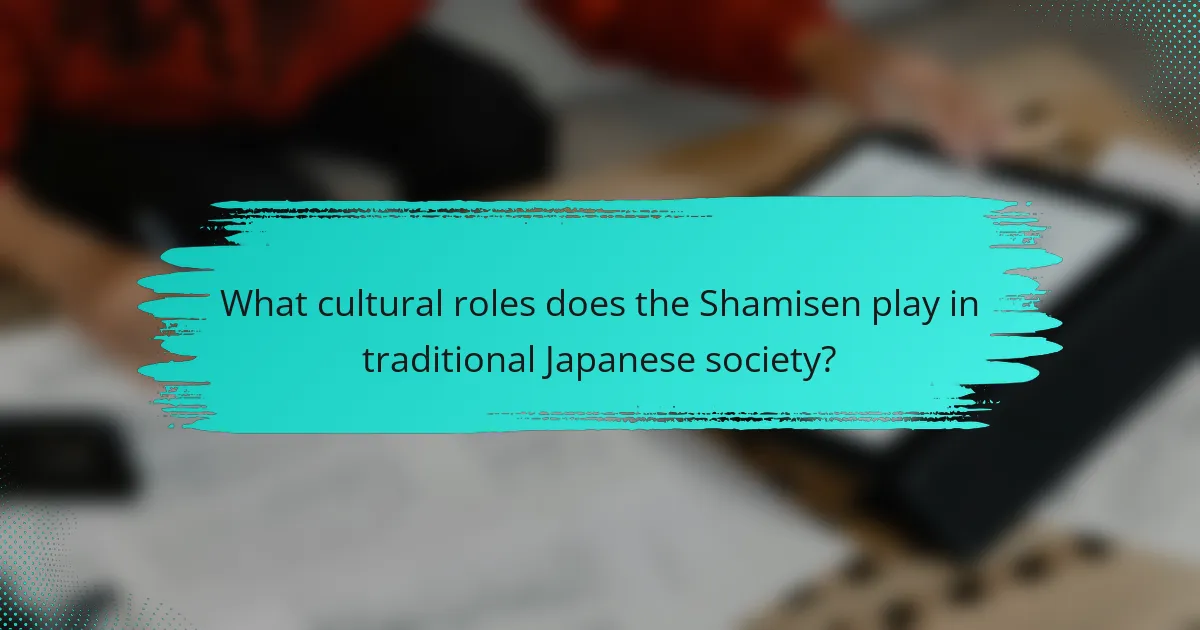
What cultural roles does the Shamisen play in traditional Japanese society?
The Shamisen plays a vital role in traditional Japanese society as a musical instrument integral to various cultural practices. It is central to storytelling through genres like Bunraku and Kabuki, where its distinctive sounds enhance narratives. The Shamisen also accompanies traditional dances and festivals, fostering community engagement and cultural preservation. Additionally, it serves as a medium for emotional expression, connecting performers and audiences through its unique tonal qualities. Its adaptability in modern music reflects ongoing cultural relevance, bridging traditional and contemporary influences.
How does the Shamisen influence storytelling and performance art?
The Shamisen significantly influences storytelling and performance art through its unique sound and emotional depth. This traditional Japanese instrument enhances narratives by providing an evocative musical backdrop. Its distinct plucking technique creates a range of tones that convey various emotions, enriching the overall performance.
In traditional storytelling forms like Bunraku and Kabuki, the Shamisen serves as a central component, guiding the audience’s emotional responses. The instrument’s versatility allows it to adapt to different storytelling styles, making it a vital element in performance art. Modern adaptations continue to explore its potential, blending traditional techniques with contemporary genres, thus expanding its cultural relevance.
Which festivals prominently feature Shamisen music?
Shamisen music prominently features in several Japanese festivals, including the Gion Matsuri in Kyoto, the Awa Odori in Tokushima, and the Nagasaki Kunchi. These festivals celebrate cultural heritage through traditional performances, showcasing the expressive qualities of Shamisen. The Gion Matsuri highlights the instrument’s role in processions, while the Awa Odori incorporates it in lively dance routines. The Nagasaki Kunchi features Shamisen in its unique blend of musical styles, emphasizing its adaptability and significance in modern festivities.
What are the regional variations of Shamisen in Japan?
Shamisen has distinct regional variations across Japan, each reflecting local culture and musical styles. In the Tsugaru region, the Tsugaru-jamisen features a fast-paced, energetic playing style, often used in folk festivals. The Nagauta style, prominent in Tokyo, is characterized by its elegant melodies and is frequently performed in Kabuki theater. The Gidayu style, associated with puppet theater, incorporates storytelling elements, while the Min’yo style emphasizes traditional folk songs from various regions. Each variation showcases unique techniques and instruments, contributing to the rich tapestry of Japanese musical heritage.
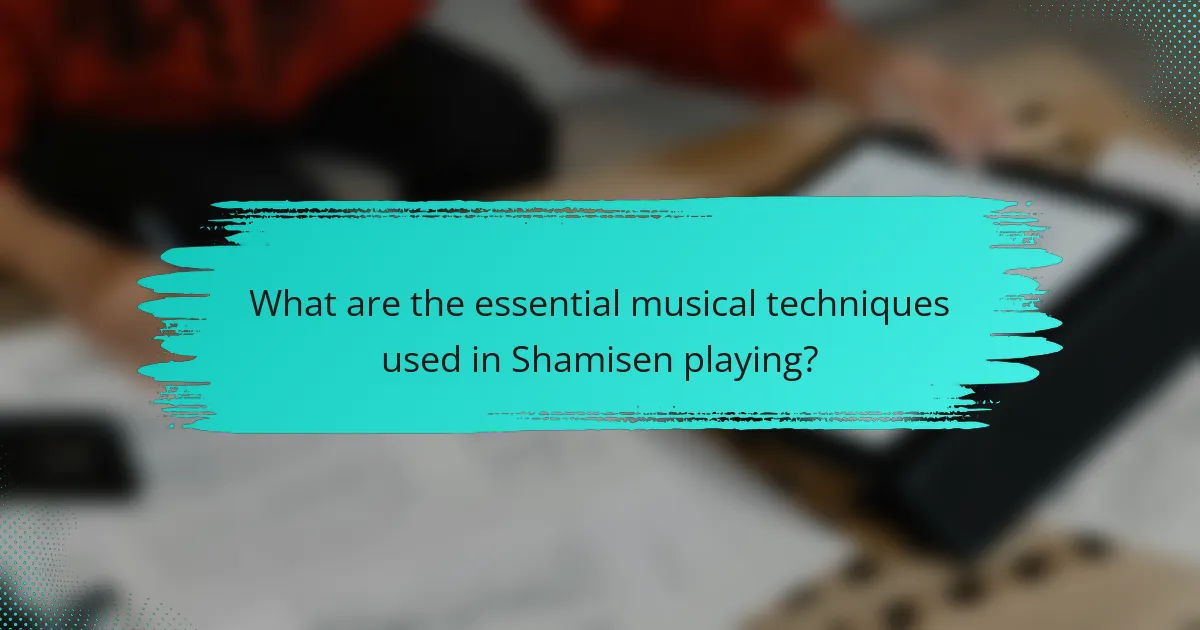
What are the essential musical techniques used in Shamisen playing?
Shamisen playing utilizes essential techniques such as plucking, sliding, and rhythmic variations. Plucking, known as “bachi,” involves striking the strings with a plectrum, creating distinct sounds. Sliding techniques, or “sawari,” allow for expressive pitch bends, enhancing emotional depth. Rhythmic variations, including “tsuzumi” and “kuchi shoga,” provide dynamic interplay, showcasing the instrument’s versatility. These techniques contribute to the shamisen’s unique cultural significance in Japanese music.
How do different playing styles affect the sound of the Shamisen?
Different playing styles significantly influence the sound of the Shamisen. Techniques such as plucking, strumming, and bowing create distinct tonal qualities. For instance, the Tsugaru style emphasizes aggressive strumming, producing a vibrant and energetic sound. In contrast, the Gidayu style features softer, more melodic plucking, resulting in a delicate tone. Each style brings unique attributes, shaping the overall musical experience. Variations in technique can also affect the instrument’s resonance and volume, highlighting the Shamisen’s versatility in traditional and contemporary music.
What techniques are used to create vibrato and pitch variation?
Vibrato and pitch variation in shamisen are created using techniques like finger bending, string pressure adjustments, and rapid oscillation of the wrist. These methods enhance emotional expression and musical depth. Finger bending alters pitch subtly, while string pressure creates dynamic shifts. Rapid wrist movement produces a characteristic vibrato, adding richness to performances.
Which types of plectra are commonly used with the Shamisen?
Commonly used plectra with the Shamisen include the bachi, which is the primary plectrum, and variations such as the tsugaru bachi and the nagauta bachi. The bachi’s size and material influence sound production.
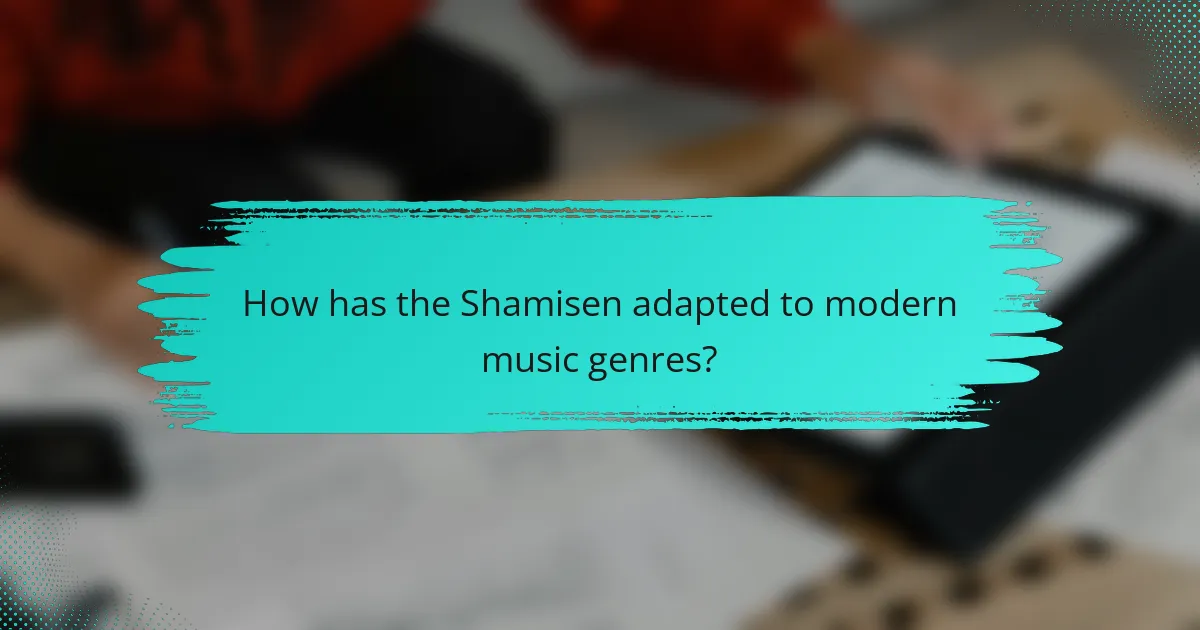
How has the Shamisen adapted to modern music genres?
The Shamisen has successfully integrated into modern music genres by blending traditional techniques with contemporary styles. This adaptation includes collaborations with pop, rock, and electronic music artists, showcasing its versatility.
Innovative musicians have introduced new playing techniques, such as percussive strumming and experimental tunings, enhancing its appeal. The Shamisen’s unique sound complements various genres, creating a fusion that resonates with diverse audiences.
Additionally, modern Shamisen players often incorporate visual elements, such as vibrant performances and multimedia presentations, to engage younger generations. This evolution helps preserve its cultural significance while ensuring relevance in today’s music scene.
What role does the Shamisen play in contemporary fusion music?
The Shamisen plays a vital role in contemporary fusion music by blending traditional Japanese sounds with various genres. Its unique attributes, such as the three-string design and distinctive picking technique, allow for innovative musical expressions. Artists incorporate the Shamisen into genres like jazz, rock, and pop, creating a rich tapestry of sound that honors its cultural roots while appealing to modern audiences. This adaptability showcases the Shamisen’s significance in evolving musical landscapes.
Which artists are leading the modern Shamisen movement?
Leading artists in the modern Shamisen movement include Yoshida Brothers, who blend traditional techniques with contemporary styles. Other notable figures are Hiromitsu Agatsuma, known for his innovative compositions, and Kenta Matsumoto, who incorporates various genres. These artists contribute to the revitalization and evolution of Shamisen music.
How do new technologies impact Shamisen performance and accessibility?
New technologies enhance Shamisen performance and accessibility by integrating digital tools and platforms. Innovations like electronic Shamisen and online tutorials broaden reach and engagement. For example, virtual reality experiences allow users to learn and play in immersive environments. Additionally, streaming services enable global audiences to access traditional and contemporary performances, fostering cultural exchange. These advancements maintain the instrument’s relevance while preserving its cultural significance.
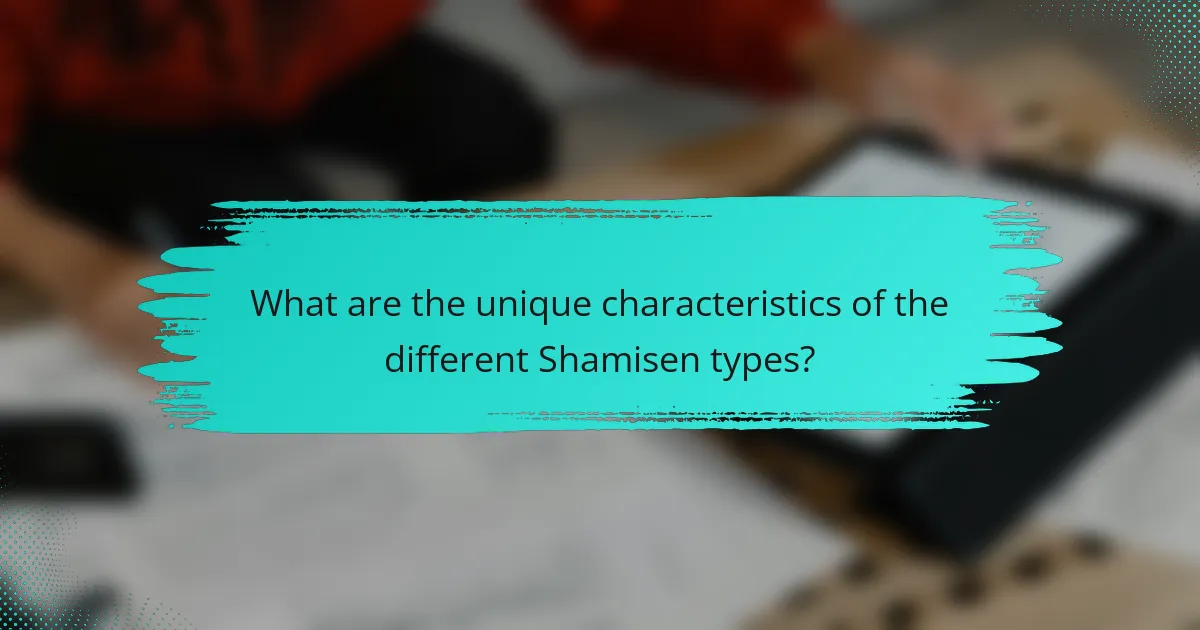
What are the unique characteristics of the different Shamisen types?
The unique characteristics of different Shamisen types include variations in shape, size, and sound. The three main types are the Tsugaru, Nagauta, and Gidayu.
The Tsugaru Shamisen features a thicker neck and a larger body, producing a robust sound ideal for energetic performances. The Nagauta Shamisen has a longer neck and a more delicate body, suited for traditional storytelling and classical music. The Gidayu Shamisen is designed for narrative performances, with a unique tuning that enhances vocal accompaniment.
Each type’s construction affects its tonal quality and playing technique, showcasing the diversity within this traditional Japanese instrument.
How does the Nagauta Shamisen differ from the Jiuta Shamisen?
The Nagauta Shamisen differs from the Jiuta Shamisen primarily in their musical styles and performance contexts. Nagauta is often associated with Kabuki theater, characterized by its lively and expressive melodies. In contrast, Jiuta focuses on more subdued, narrative-driven music, commonly performed in solo or smaller ensemble settings.
The construction of the instruments also varies; Nagauta Shamisen typically has a larger body, enhancing its resonance for dramatic performances. Jiuta Shamisen, on the other hand, features a slightly smaller body, which supports its intricate finger techniques.
Both styles utilize different playing techniques and repertoires, reflecting their unique cultural significance within Japanese music. Nagauta emphasizes rhythm and theatricality, while Jiuta highlights melodic storytelling.
What makes the Tsugaru Shamisen distinct in its performance style?
The Tsugaru Shamisen is distinct due to its vigorous performance style and unique techniques. It emphasizes rapid strumming and dynamic rhythms, creating an energetic and expressive sound. Players often incorporate improvisation, showcasing individual artistry. The use of a thicker neck and heavier strings allows for deeper tones, enhancing its emotional impact. This style reflects the cultural heritage of the Tsugaru region, making it a vital part of Japanese folk music.
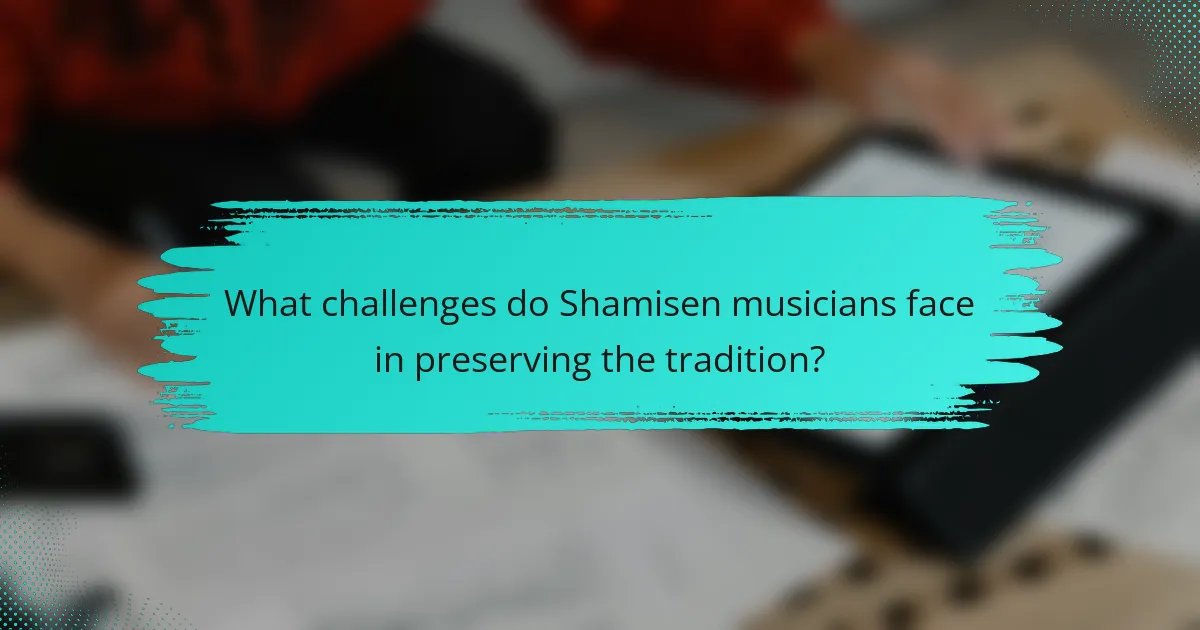
What challenges do Shamisen musicians face in preserving the tradition?
Shamisen musicians face significant challenges in preserving their tradition, including declining interest, lack of funding, and generational gaps. The younger audience often prefers modern music, which diminishes the appeal of traditional Shamisen. Additionally, limited financial support for training and performances hampers the growth of this art form. Musicians struggle to pass down techniques and cultural knowledge, risking the loss of unique attributes inherent in Shamisen music. As a result, the preservation of this cultural heritage relies heavily on dedicated practitioners and innovative adaptations to engage new audiences.
How can Shamisen education be improved for future generations?
Shamisen education can be improved by integrating modern teaching methods, expanding accessibility, and fostering cultural exchange. Incorporating technology, such as online classes and interactive apps, can engage younger audiences. Collaborations with diverse musical genres can broaden the appeal and relevance of Shamisen. Additionally, promoting workshops and community events can enhance hands-on learning experiences.
What are the common misconceptions about Shamisen music?
Many misconceptions exist about Shamisen music, often overshadowing its cultural depth. One common myth is that Shamisen is solely a traditional art form, ignoring its modern adaptations and fusion with other genres. Another misconception is the belief that it requires extensive training to appreciate, while in reality, its emotive power can resonate with diverse audiences, regardless of musical background. Additionally, some people assume that Shamisen music is exclusively melancholic, overlooking its capability to convey a wide range of emotions, including joy and celebration. Lastly, there is a notion that Shamisen is only prevalent in Japan, when in fact, its influence has spread globally, inspiring various music styles and performances.
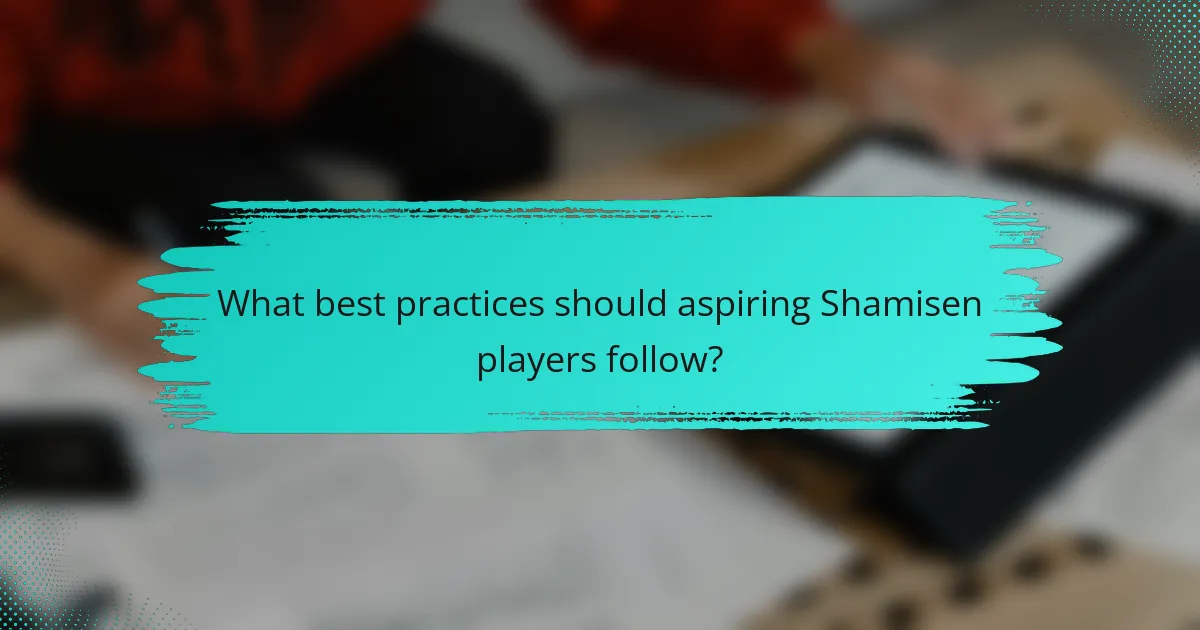
What best practices should aspiring Shamisen players follow?
Aspiring Shamisen players should focus on consistent practice, understanding the instrument’s cultural roots, and exploring various musical styles. Developing proper technique is crucial for mastering this traditional Japanese instrument.
1. Practice regularly to build muscle memory and improve skills.
2. Learn about the historical and cultural significance of the Shamisen to deepen appreciation.
3. Experiment with different genres to discover unique sounds and techniques.
4. Seek feedback from experienced players to refine your performance.
5. Attend workshops or classes to gain hands-on experience and mentorship.
How can one effectively practice Shamisen techniques at home?
To effectively practice Shamisen techniques at home, establish a routine that includes focused practice sessions, use online tutorials, and engage with community resources. Consistent practice enhances skill development and musical understanding.
Start with basic techniques such as plucking and strumming, gradually incorporating more complex pieces. Utilize instructional videos to learn proper posture and hand positioning. Record your practice to track progress and identify areas for improvement.
Engaging with online forums or local Shamisen groups can provide feedback and motivation. Regularly listening to Shamisen music will also deepen your appreciation and inform your practice.
What resources are available for learning Shamisen online?
Online resources for learning Shamisen include video tutorials, online courses, and social media groups. Websites like YouTube offer free lessons, while platforms like Udemy provide structured courses. Additionally, communities on Facebook and forums like Reddit foster discussion and support among learners. These resources enhance understanding of techniques and cultural significance.
